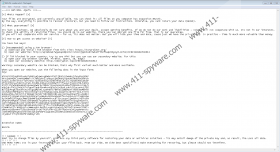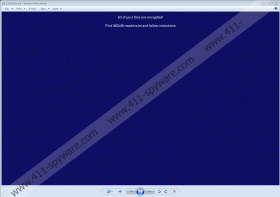Sodinokibi Ransomware Removal Guide
Sodinokibi Ransomware is a threat that could cause a lot of trouble for its victims. Our specialists say the malicious application might encrypt various files located on a computer and delete user’s shadow copies. Also, it seems the threat might able to connect to the Internet without any permission, which could be dangerous. If you come across it, we highly recommend reading our full report to learn all about it. Users who decide to eliminate Sodinokibi Ransomware may also find useful our deletion steps located at the end of this article. The malware’s removal is recommendable for anyone who does not want to put up with the hackers' demands. It may not help decrypt the threat’s enciphered files, but it is still possible to recover such data if you have backup copies on removable media devices, cloud storage, etc.
If you have never heard about ransomware applications, you may wonder how they enter the system. Of course, knowing this is crucial if you want to be able to protect your device from such malware in the future. According to our specialists, Sodinokibi Ransomware might be spread through unsecured RDP connections, or it could enter the system while exploiting its other vulnerabilities. Therefore, we highly recommend strengthening the system. For starters, you should update your operating system and other software installed on the computer that could be out of date. As you see, old versions may have exploitable weaknesses. Also, it would be wise to change passwords that are old, too weak, or could be compromised. Lastly, we suggest installing a reliable security tool that could help you identify potentially malicious content and guard the system against it.
Once Sodinokibi Ransomware gets in, it should start with encrypting files located in the following directories: %USERPROFILE%\Favorites, %USERPROFILE%\Downloads, and %USERPROFILE%\Desktop. Our researchers say the malware should also encipher data in %Homedrive%\Users\Default, but it seems it does not touch files with .sys or .bat extensions in this particular folder. What’s more, the malicious application should mark all files it encrypts with a unique extension generated from six random characters, for example, file.pdf.589r6n. Data that receives the malware’s extension should become unrecognizable and to prevent users from restoring it, Sodinokibi Ransomware ought to delete all shadow copies. Nonetheless, you can still replace encrypted files with backup copies if you have them placed somewhere safe.
Moreover, the malicious application does not just encrypt users’ files. It also changes its victims’ background images to place a message asking to read a particular document containing a ransom note. According to the note the hackers are prepared to restore files for the victim if he only contacts them as instructed and puts up with all of their demands. The bad news is that these people will most likely ask you to pay for decryption and given there are no guarantees they will decipher your data (even if they promise so), paying the ransom could be risky.
If you are not prepared to take any chances and would rather restore data with backup copies, we encourage you to eliminate Sodinokibi Ransomware. To remove the threat manually, you could use the instructions located below. For those who find our steps too complicated, we recommend employing a reliable antimalware tool instead.
Get rid of Sodinokibi Ransomware
- Tap Ctrl+Alt+Delete.
- Pick Task Manager.
- Select the Processes tab.
- Look for a process associated with the malware.
- Select the process and click End Task.
- Leave Task Manager.
- Tap Win+E.
- Go to these locations:
%TEMP%
%USERPROFILE%\Downloads
%USERPROFILE%\Desktop - Find the malicious file opened before the system got infected, right-click it, and select Delete.
- Find documents containing ransom notes, e.g., 589r6n-readme.txt, right-click them, and select Delete.
- Close File Explorer.
- Empty Recycle Bin.
- Restart the computer.
Sodinokibi Ransomware Screenshots:



